Types of Grasshoppers: Grasshoppers are insects that delight children but frustrate gardeners. Typically green or brown, these ground-dwelling creatures are known for their large hind legs, perfect for leaping. Some species can fly, and locust swarms can cause severe crop damage. Grasshoppers vary greatly in size, from tiny ones just a few millimeters long to the sizable hedge grasshopper, which can reach over 3 inches (75 mm) in length.
Properly identifying grasshoppers, katydids, and crickets often begins with examining pictures of these insects. Here’s an overview for all interested visitors, covering their basic information, shapes, colors, and sizes.
Distinguishing grasshoppers from other insects is typically straightforward due to their distinct characteristics. However, crickets and katydids can often be mistaken for grasshoppers, as they share similar traits. It’s important to remember that while all locusts fall under the grasshopper category, not every grasshopper is a locust.
This guide offers practical advice for identifying common grasshopper species. By providing detailed descriptions and illustrative pictures, it will help you easily recognize these chirping, plant-eating insects in your garden.
What is a Grasshopper?
Grasshoppers are winged insects with six legs, belonging to the suborder Caelifera. With over 8,000 species, these ancient herbivores are known for their chewing abilities. In many parts of the world, grasshoppers are significant pests, damaging vegetation, crops, and vegetables.
Some short-horned grasshoppers can transform into locusts under certain conditions. Overcrowding triggers changes in color, feeding intensity, and rapid breeding, turning solitary insects into swarms of destructive pests. These locust swarms can devastate crops, leading to famines as they strip trees and plants of their vegetation.
How to Identify a Grasshopper
Identifying grasshoppers involves examining their body shape, color, and size. Grasshoppers, like all insects, have six legs and a body divided into three segments: head, thorax, and abdomen. They possess long hind legs and prominent eyes on a vertically attached head.
Most are brown or green, with some black varieties, though some species, like the rainbow grasshopper, are colorful. They have large chewing mouthparts and typically short antennae, except for long-horned grasshoppers. Grasshoppers are known for their distinctive chirping sounds, recognizable to other grasshoppers.
Types of Grasshoppers — Identification Guide With Pictures
Grasshoppers come in thousands of species, varying greatly in size and color patterns. They typically rest with their recognizable back legs in a ‘V’ shape. Some are small, while others can be quite large.
To identify common grasshopper species, look for key features such as body shape, color, leg structure, and antennae length. This guide will help you distinguish between various species, providing detailed descriptions and images. Continue reading to learn more about identifying different types of grasshoppers.
Common Green Grasshopper (Omocestus viridulus)
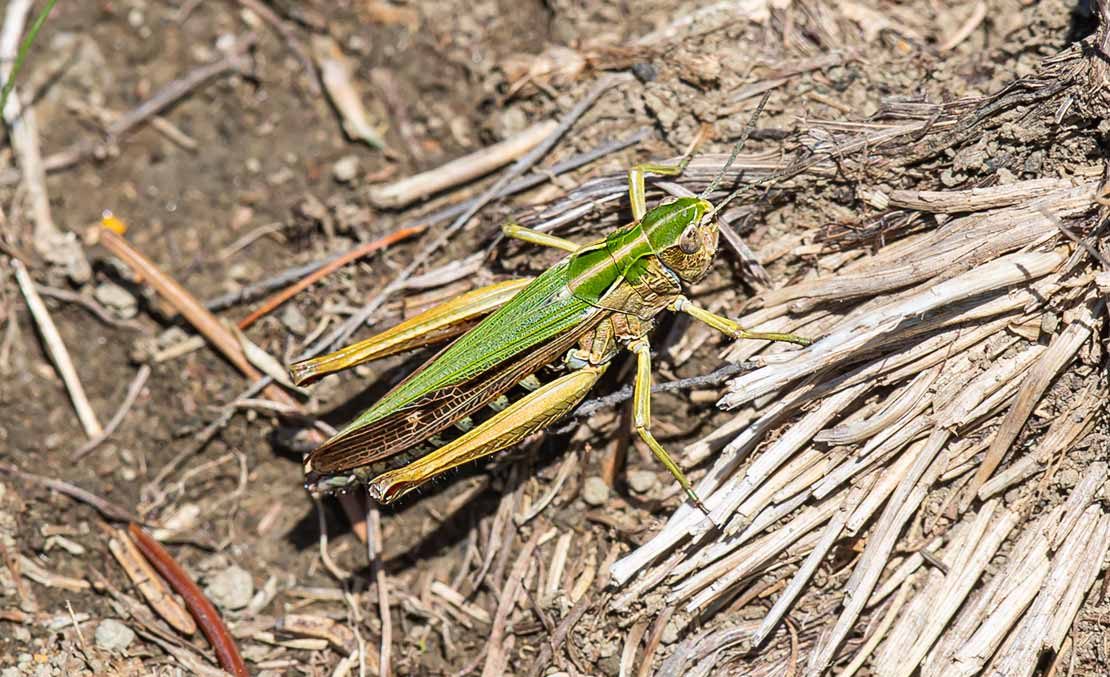
The common green grasshopper is a mid-sized insect characterized by its green body and some brown on its abdomen. It has short antennae, brown or yellow eyes, and robust hind legs. A notable feature is its long tube-like organ at the rear. Measuring 0.67” to 0.79” (17 – 20 mm) long, these grasshoppers produce distinctive calling songs and ticking sounds to attract mates. Females are typically lime green, while males are mostly brown with black and white mottled patterns.
Identification: Look for lime green coloration, brown eyes, and brownish stripes along the abdomen.
Eastern Lubber Grasshopper (Romalea microptera)
The eastern lubber grasshopper is one of North America’s largest grasshoppers, measuring about 3” (75 mm) long. It features colorful patterns in black, reddish-pink, yellow, and orange, which can change with conditions and growth stages. Known for its climbing ability rather than flying or hopping, this grasshopper’s bright colors warn predators of its foul taste and smell.

Native to the southeastern United States, its coloration varies by region. In Florida, it’s primarily black with yellow or red stripes, while in other southern states, it displays multi-colored patterns. These grasshoppers can severely damage citrus trees, ornamental shrubs, and vegetable crops.
Identification: Look for the bright yellow, red, orange, and black body, large eyes, and colorful legs.
Common Field Grasshopper (Chorthippus brunneus)
The common field grasshopper is identifiable by its mottled brown, black, and creamy white patterns. These grasshoppers can also appear green, purple, black, or white, and may have stripes instead of mottled patterns. They typically grow 0.70” to 0.94” (18 – 24 mm) long.
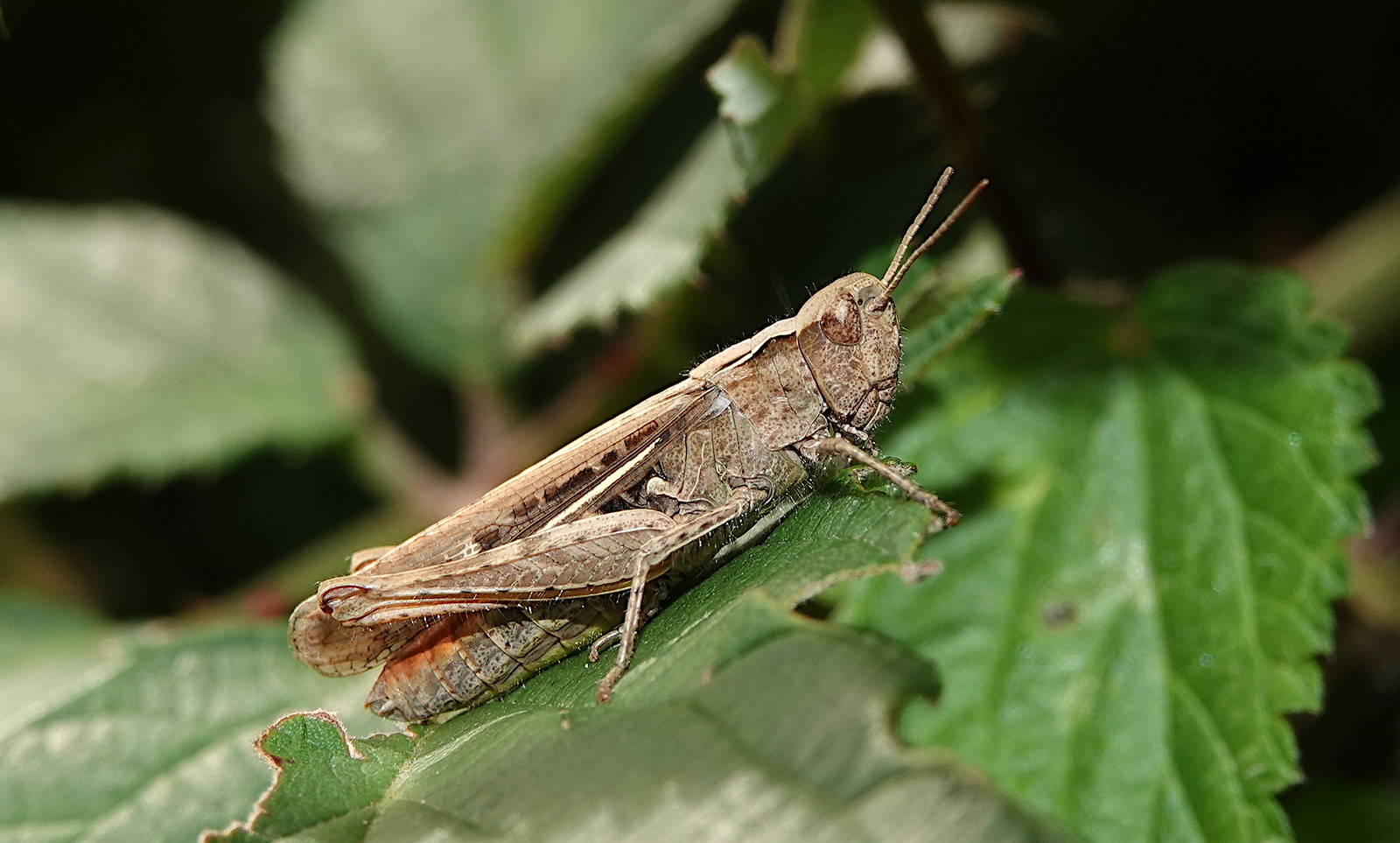
Known for their loud chirping on warm sunny days, these grasshoppers also have noticeably large hind legs. Their hairy undersides and varied coloration make them tricky to identify up close.
Identification: Look for mottled brown patterns, large rear legs, and the distinctive chirping noise during warm days.
Meadow Grasshopper (Pseudochorthippus parallelus)
The Meadow Grasshopper (Pseudochorthippus parallelus) is a diminutive green insect adorned with distinctive black stripes running along its back. These small creatures sport elegant ‘V’ patterns on their hind legs, complemented by elongated antennae and relatively large eyes positioned laterally on their heads. Female meadow grasshoppers exhibit a palette of mottled brown and black hues, often tinged with shades of green on their abdomens.
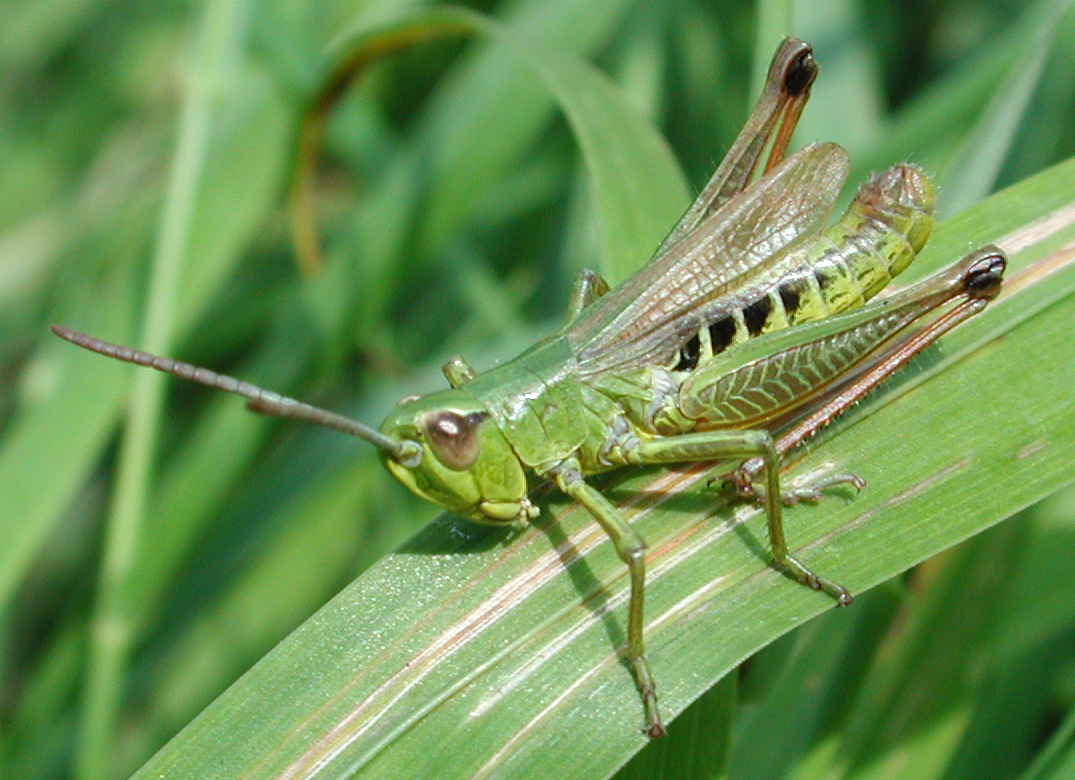
Measuring approximately 0.75 inches (20 mm) in length, these winged insects are predominantly brown or green in coloration but are non-flying. Instead, they navigate their environment through agile leaps onto vegetation or by scaling blades of grass.
While green remains the predominant hue among meadow grasshoppers, genetic factors rather than environmental conditions give rise to variations in color, including shades of brown, pink, and purple-red.
Identification of these grasshoppers hinges on their small size, green coloration, and distinctive black abdominal stripes.
Spur-Throated Grasshoppers (Melanoplus)
Spur-Throated Grasshoppers (Melanoplus) comprise a diverse genus of large grasshoppers indigenous to North America. These striking insects are characterized by their vibrant and intricately patterned bodies. Adorned with slender white lines along their wings, they feature distinct black and green markings on their head and thorax, complemented by legs in a pale brown hue.
Below are the identifying characteristics of some of these grasshopper species:
Red-legged grasshopper (Melanoplus femurrubrum)
Acrididae (short-horned grasshoppers) in the order Orthoptera (grasshoppers, katydids, crickets)
Description The Red-Legged Grasshopper is a common species of short-horned grasshopper found throughout Missouri. Typically reaching up to 1 inch in length, it is often observed darting or taking flight in open habitats. This species has several closely related counterparts with similar appearances.

Coloration in the Red-Legged Grasshopper varies widely, encompassing shades of red-brown, yellow, dark brown, green, and olive green. Its distinguishing feature is the bright red or yellowish hind legs adorned with a black herringbone pattern. Belonging to the group of spur-throated grasshoppers, it exhibits a small pointed “spur” located between the bases of its forelegs.
When startled, these medium-sized grasshoppers can cover distances of up to 40 feet in flight, characterized by swift and steady movement approximately one yard above the vegetation.
Similar Species The genus Melanoplus encompasses nearly 250 species in North America north of Mexico, making precise identification challenging without detailed examination of anatomical structures and characteristics. For accurate identification, consulting an expert is often necessary.
For further information on Red-Legged Grasshoppers and other short-horned grasshoppers, visit their group page.
Size Adult length: up to about 1 inch. This species is considered relatively small among grasshoppers.
Pine tree spur-throat grasshopper (Melanoplus punctulatus)
Family Acrididae (short-horned grasshoppers) in the order Orthoptera (grasshoppers, katydids, crickets)
Description The Pine Tree Spur-Throat Grasshopper typically inhabits wooded areas, where its mottled brownish-gray coloration provides effective camouflage against tree trunks during rest. Notably, the outer surface of its hind femurs (thigh-like segments) displays distinct bands of alternating black and gray, while the inner surface exhibits a characteristic bright red hue.

This species is widely distributed across North America, with populations varying in overall coloration, which can range from olive and rust to gray or tan.
Males of the Pine Tree Spur-Throat Grasshopper are slightly smaller than females and feature cerci (appendages at the tip of the abdomen) shaped like flattened clubs or boots, a distinguishing trait among grasshoppers.
For further information on this species and other short-horned grasshoppers, visit their group page.
Other Common Names
- Grizzly Locust
- Grizzled Grasshopper
- Mottled Grasshopper
Size
- Females reach up to about 1½ inches in length
- Males are smaller, measuring about 1 inch
Packard’s grasshopper (Melanoplus packardii)
Distribution Packard’s Grasshopper is typically found across prairie regions, favoring loose, sandy soils. In Alberta, there is variability in coloration, with southern specimens generally appearing paler. Although less common than the Two-Striped Grasshopper, it poses a moderate threat, particularly in areas with sandy soils and dry conditions where population numbers can increase.
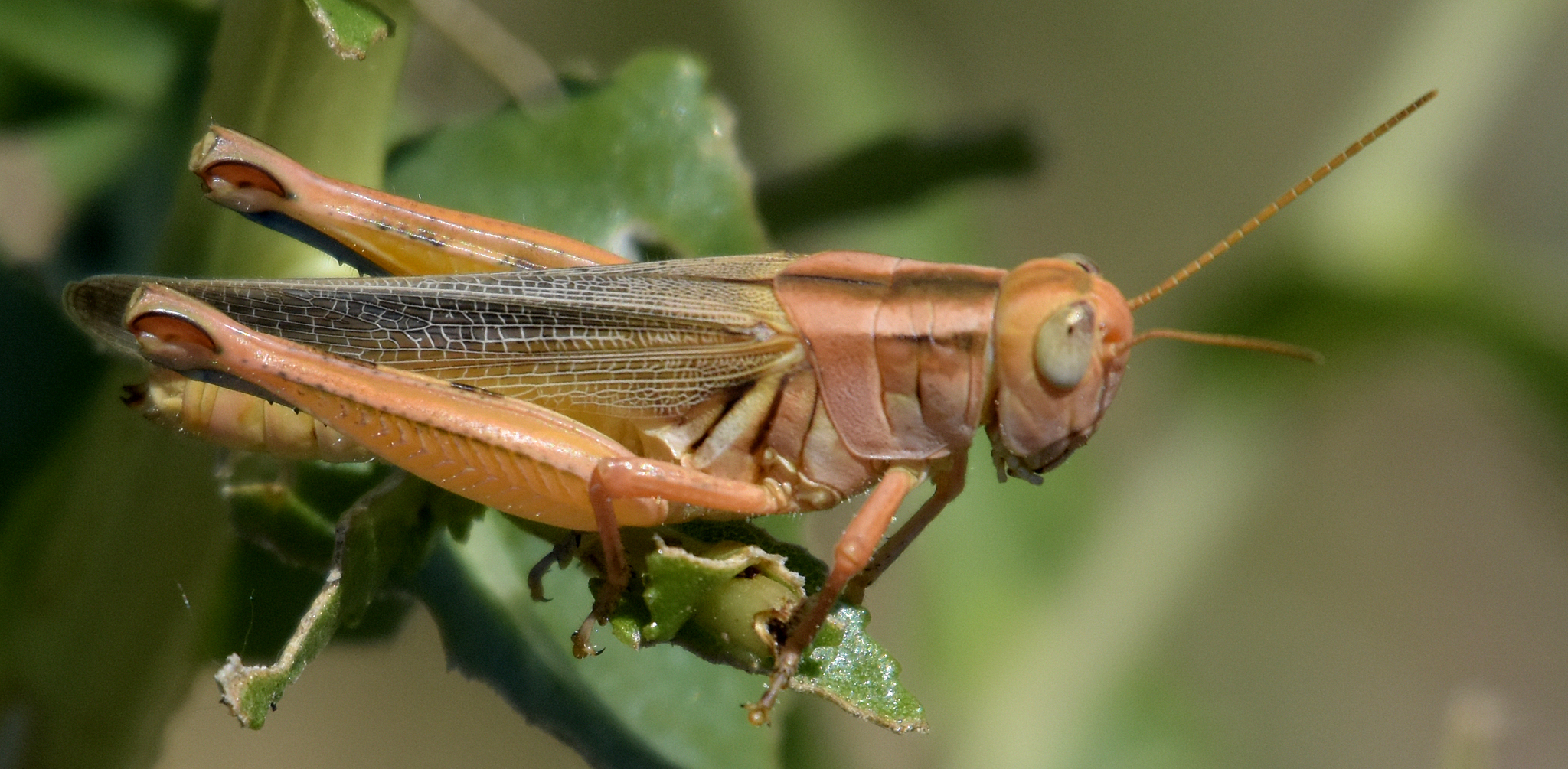
Description Adult Packard’s Grasshoppers exhibit a color range from grey to dark yellow and measure approximately 27 to 32 mm (1.1 to 1.3 inches) in length. They are characterized by two light-colored stripes extending from just behind the eyes to the rear margin of the thorax. Their forewings are uniformly grey without distinct stripes, while the last two segments of their hind legs are blue-green.
When newly hatched, Packard’s Grasshoppers are pale green to yellow-brown, speckled with numerous small dark spots, resembling they have been dusted with pepper.
Identification Young Packard’s Grasshoppers feature scattered black dots on their bodies, contributing to their peppered appearance.
Green-legged grasshopper (Melanoplus viridipes)
Description The Green-Legged Grasshopper is characterized as a short-winged species. Adult males typically range in body length from 17.5 to 18.5 mm, while females are larger, measuring between 21.5 and 25.5 mm in length. Key distinguishing features include solid green forelegs and midlegs, a black lateral stripe running the full length of the pronotum, and short wings covering less than half of the abdomen—this combination serves as a diagnostic characteristic. Additionally, the lower half of the side of the pronotum is white, and the top of the pronotum is either entirely black or black with white patches.
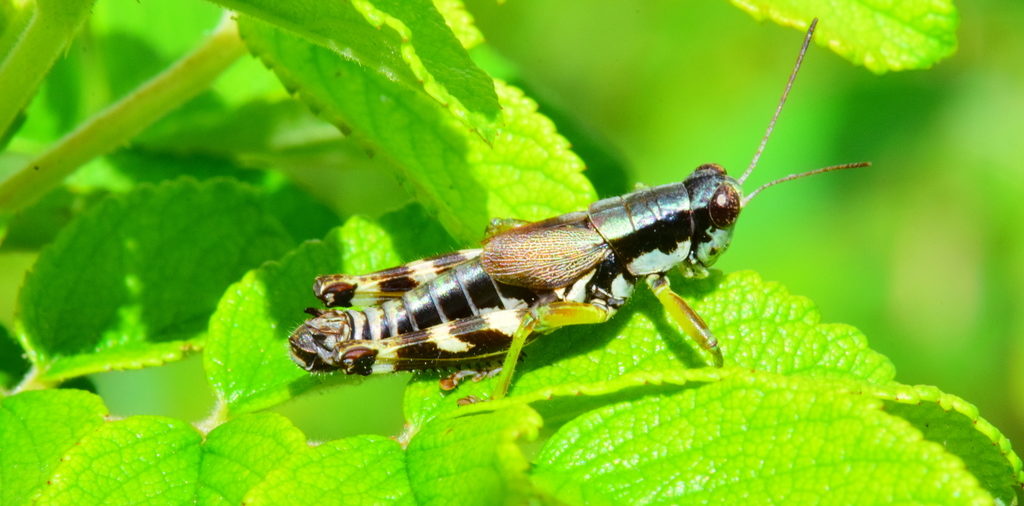
Identification Melanoplus viridipes can be differentiated from Dendrotettix and Appalachia species by their less extensive brown coloration on the hind femur, the presence of a prominent black stripe along the mid-line of the pronotum, and wing pads that are not fully developed over the back (in some Dendrotettix, wings may be fully developed). Adult Booneacris lack wings altogether.
Migratory grasshopper (Melanoplus sanguinipes)
Description The Migratory Grasshopper is renowned for its adaptability and widespread success across various ecoregions of the Canadian grasslands. It exhibits notable variability in coloration and physical features, including wing length. Among all species within the genus Melanoplus, M. sanguinipes holds the broadest distribution, extending as far south as Florida.
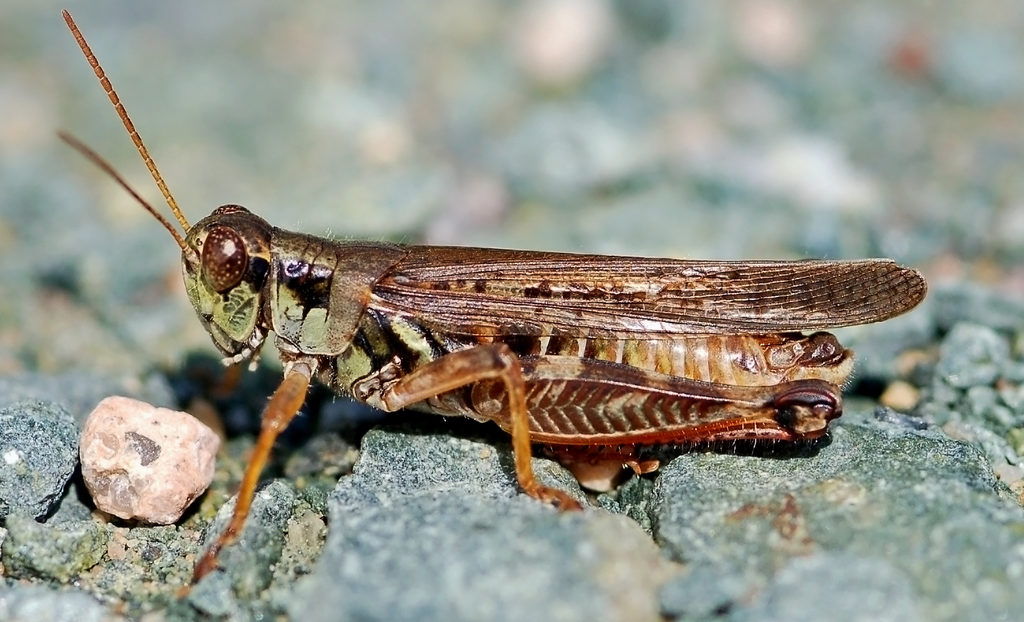
Identification Adult Migratory Grasshoppers typically range in length from 23 to 28 mm (0.9 – 1.1 inches) and display hues from brownish to yellowish. Their hind legs are distinctly marked with a series of black bands. Newly hatched grasshoppers feature black bands on the top of their thorax, which shift to the sides during the adult stage.
Habitat Adult females primarily deposit their eggs in stubble fields, drift soil, weedy pastures, brome and alfalfa pastures, and roadside ditches. Summerfallow fields devoid of weeds generally lack egg deposits, even if covered substantially with debris.
Locusts
Locusts, categorized as short-horned grasshoppers, undergo phases where they swarm together in large groups. Interestingly, there is no clear distinction between locusts and grasshoppers as species—they are fundamentally the same. The key difference lies in their behavior: locusts transform into destructive pests during swarming phases, which typically occur when vegetation experiences rapid growth after prolonged droughts.
Estimates suggest that swarms can reach densities of up to 390 million locusts per square mile, capable of consuming food equivalent to that needed by 35,000 people in a single day.
Identification Features of Locusts
Locusts exhibit specific identification features during their swarming phases:
Coloration and Size: They commonly appear in uniform shades of brown or yellow and can measure between 1 to 2 inches in length during swarming.
Behavioral Shifts: When swarming, locusts display intensified feeding and migratory behaviors, contrasting with their solitary counterparts.
Morphological Adaptations: Some species develop elongated wings and robust hind legs, facilitating their mobility over long distances.
Environmental Impact: Swarming locusts pose significant threats to agriculture and ecosystems due to their massive numbers and voracious appetite.
Here are identification features of some grasshoppers that are classified as locusts:
Migratory locust (Locusta migratoria)
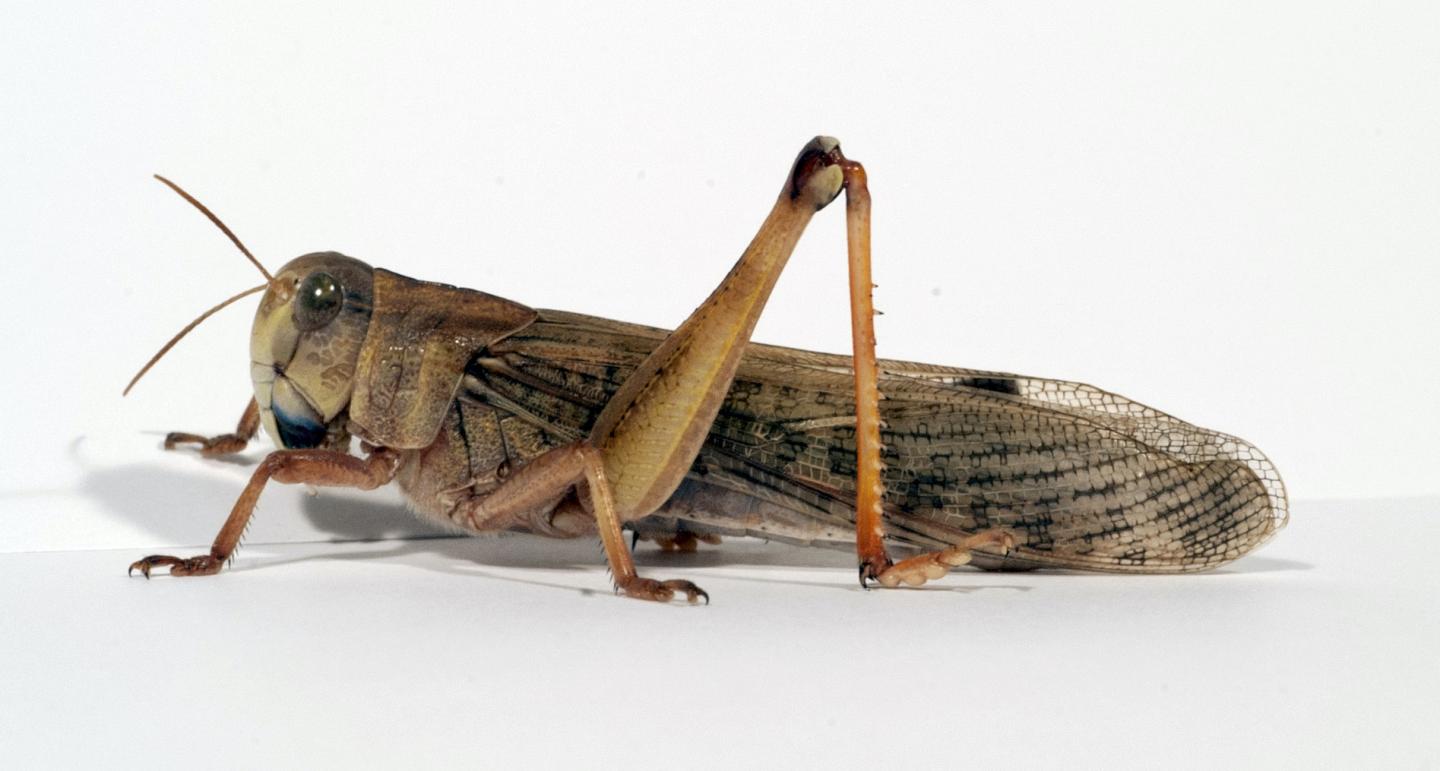
The Migratory Locust is a large brownish grasshopper adorned with yellow patterns on its wings, abdomen, and head. Characteristic features include spiny hind legs, small eyes, and short antennae. This species typically grows between 1.57 to 2.36 inches (40 – 60 mm) in length.
Garden Locust (Acanthacris ruficornis)
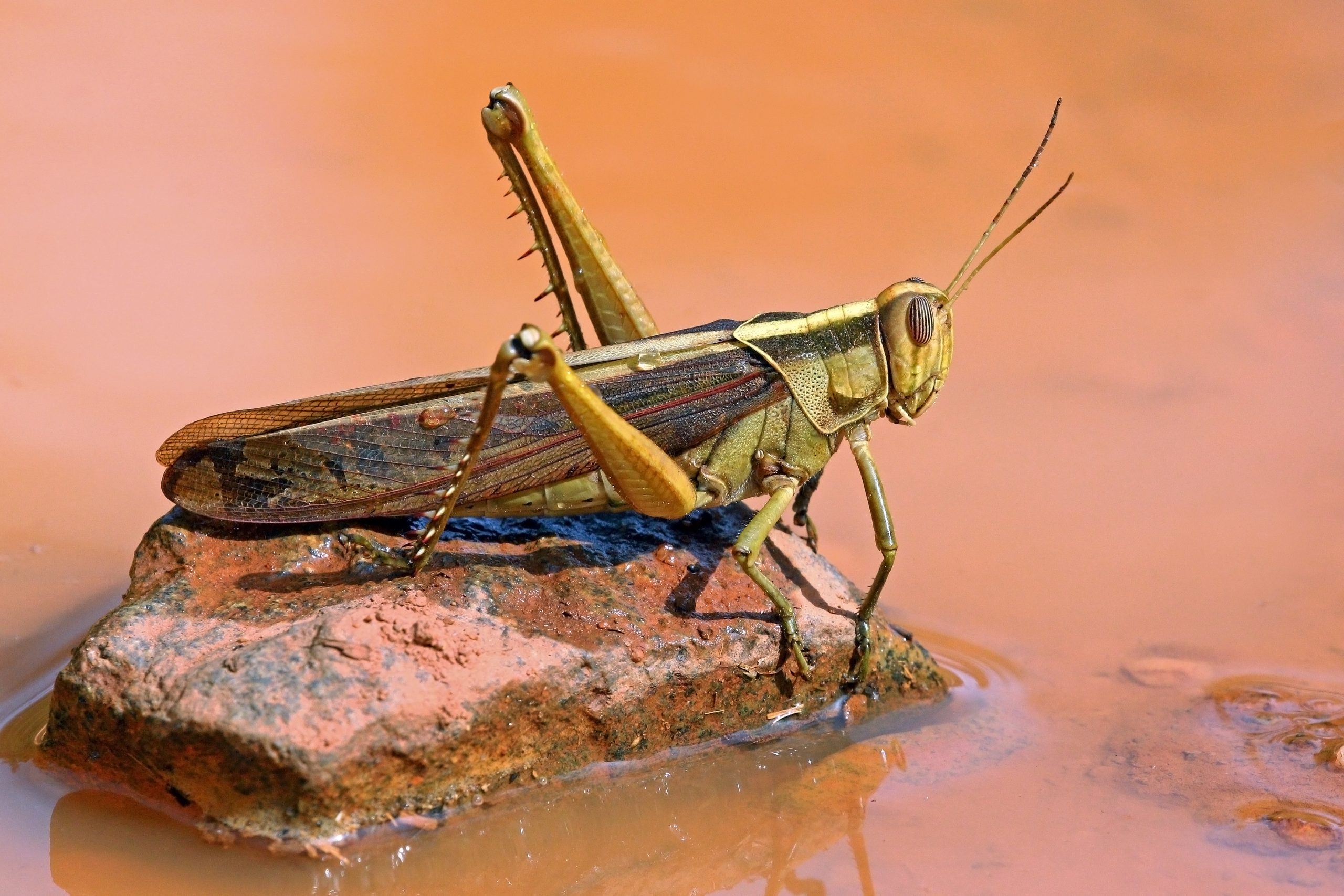
The Garden Locust is a bird grasshopper type of locust characterized by its greenish body with dark brown wings. It features spiny hind legs and a greenish abdomen, with a relatively small head in proportion to its large body. This species can reach lengths of up to 3 inches (75 mm).
Desert Locust (Schistocerca gregaria)
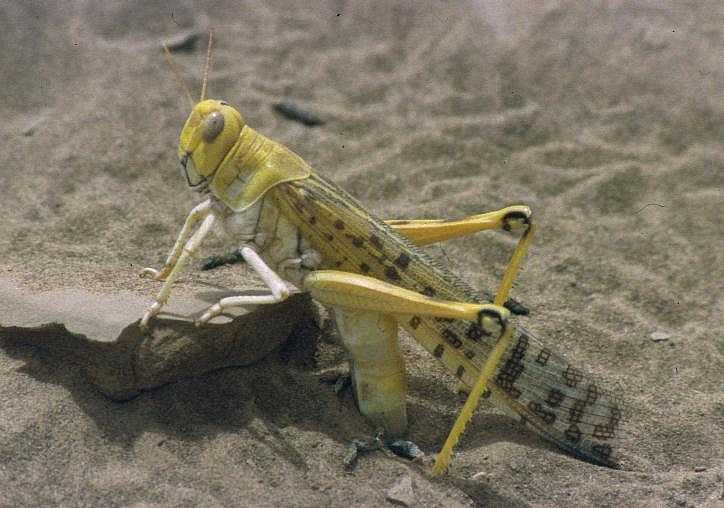
The Desert Locust is a large yellowish-green grasshopper commonly found in desert environments. This gigantic species can reach sizes of up to 3.14 inches (80 mm) in length. It is characterized by pale-yellow hind legs, grayish forelegs, and short antennae.
Western Horse Lubber Grasshopper (Taeniopoda eques)
The Western Horse Lubber Grasshopper is one of the largest grasshopper species in North America, growing up to 2.75 inches (70 mm) in length. It features distinctive fine vein-like yellow patterning on its black wings. This colorful grasshopper displays a dark brown thorax with yellow margins and a vivid yellow and brown head.
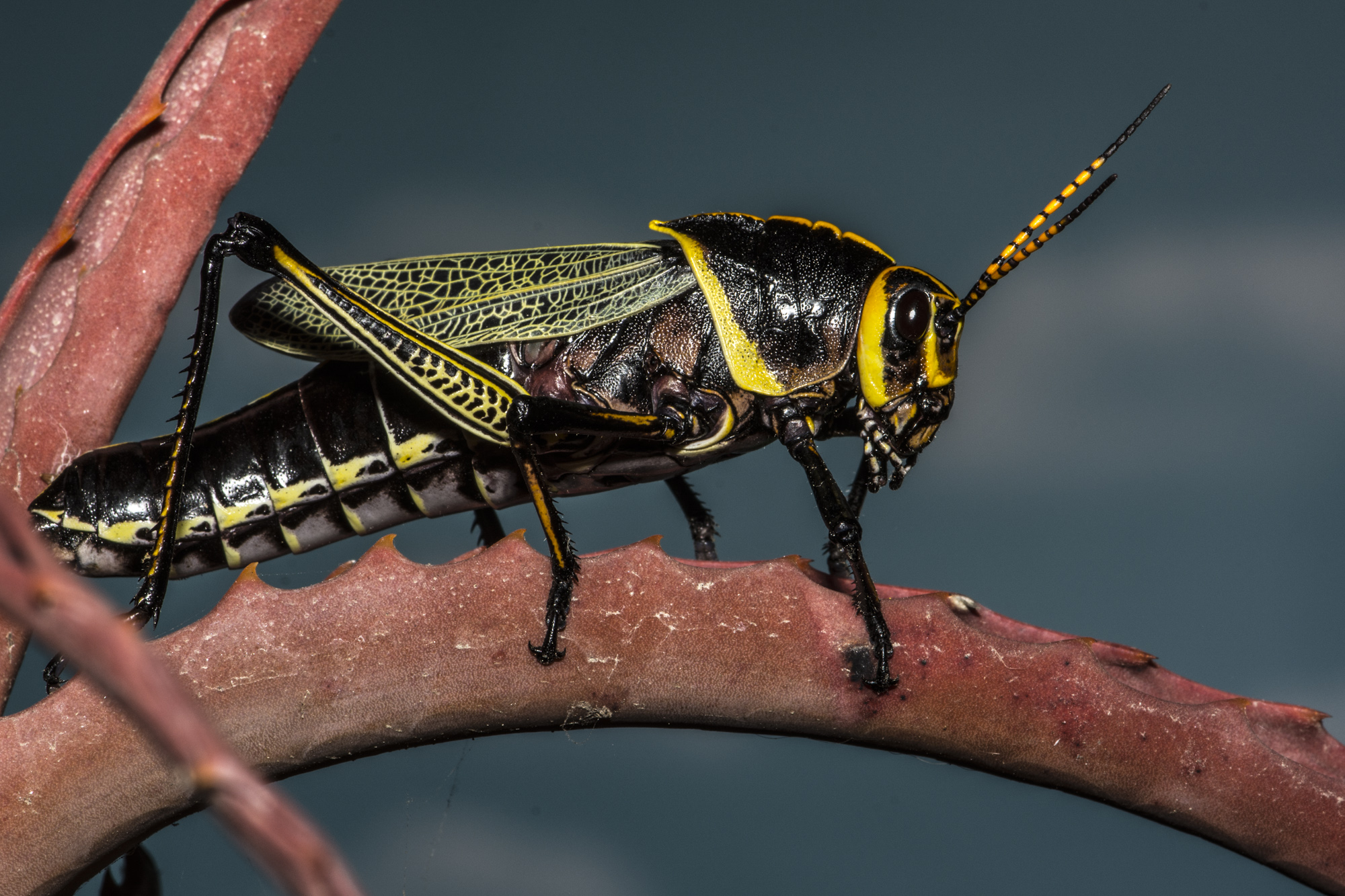
Other identifying features of this large, blackish grasshopper include yellow patterns on its black legs, yellow antennae, and yellow markings along its black abdomen. There is notable variation within the species, with individuals in southern states often exhibiting bright yellow coloring instead of black.
Despite having large wings, the Western Horse Lubber Grasshopper is incapable of flight. Interestingly, its wings extend past its abdomen, a unique characteristic among grasshoppers.
This black grasshopper is commonly found in desert bushes and grasslands, particularly in Texas and Arizona.
Grasshopper Identification
The Western Horse Lubber Grasshopper is recognized by its substantial size and distinctive yellow markings that adorn its body.
White-Lined Bird Grasshopper (Schistocerca albolineata)
The White-Lined Bird Grasshopper is a species of short-horned grasshopper known for its striking yellow and black coloration. This brightly-colored insect features a yellow body adorned with distinct black bands and yellow legs. Additionally, it has rusty-brown wings with mosaic patterning. These relatively large grasshoppers can grow up to 2 inches (50 mm) in length.
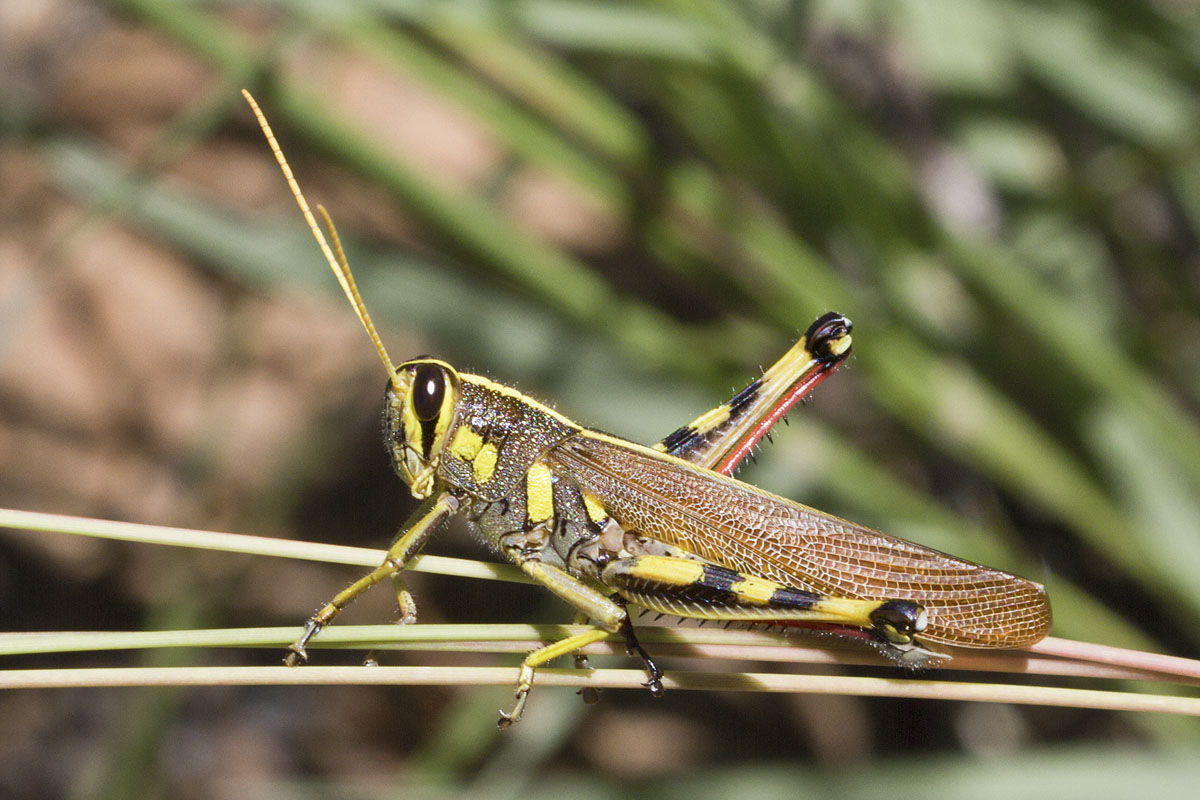
Grasshopper Identification
The White-Lined Bird Grasshopper is recognized by its yellow body with prominent black bands on its abdomen and legs.
Rainbow Grasshopper (Dactylotum bicolor)
The Rainbow Grasshopper is renowned as one of the most colorful species in North America. Easily distinguishable by its vibrant yellow, orange, and bluish markings, it exhibits a rainbow-like coloration. This unique grasshopper is characterized by tiny wing pads and the absence of functional wings, rendering it incapable of flight.
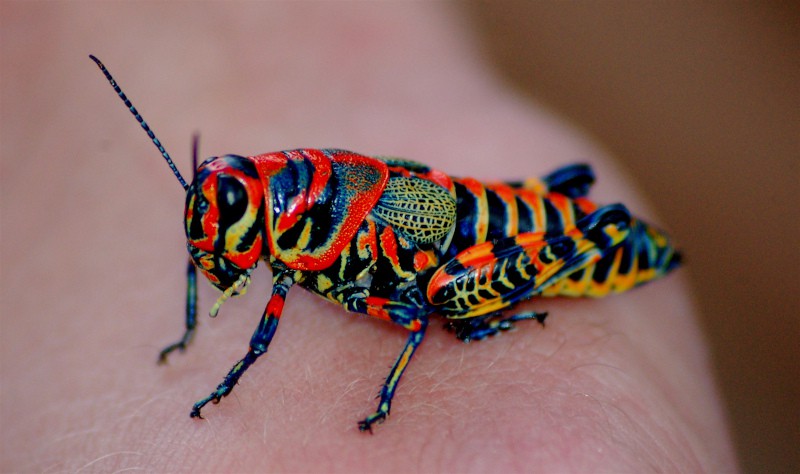
Female Rainbow Grasshoppers grow up to 1.4 inches (35 mm) in length, while males are notably smaller, measuring only 0.8 inches (20 mm). Their bright colors serve as a defense mechanism against predators.
These plant-eating insects are commonly found throughout the Great Plains of North America, inhabiting prairies, grasslands, and vegetated areas.
Grasshopper Identification
The Rainbow Grasshopper is easily identifiable by its distinctive orange and yellow striped body. It lacks wings altogether and features colorful hind legs, as well as bluish forelegs and antennae.
Silent Slant-Faced Grasshopper (Acridinae)
Silent slant-faced grasshoppers belong to a large subfamily characterized by their distinctive slanted faces. Unlike other grasshoppers, they do not possess hind leg pegs that produce clicking sounds. Visually, these grasshoppers resemble stick insects more than typical grasshoppers.
The female silent slant-faced grasshopper measures between 1.41 to 2.08 inches (36 – 53 mm) in length, while the male ranges from 1 to 1.50 inches (25 – 38 mm).
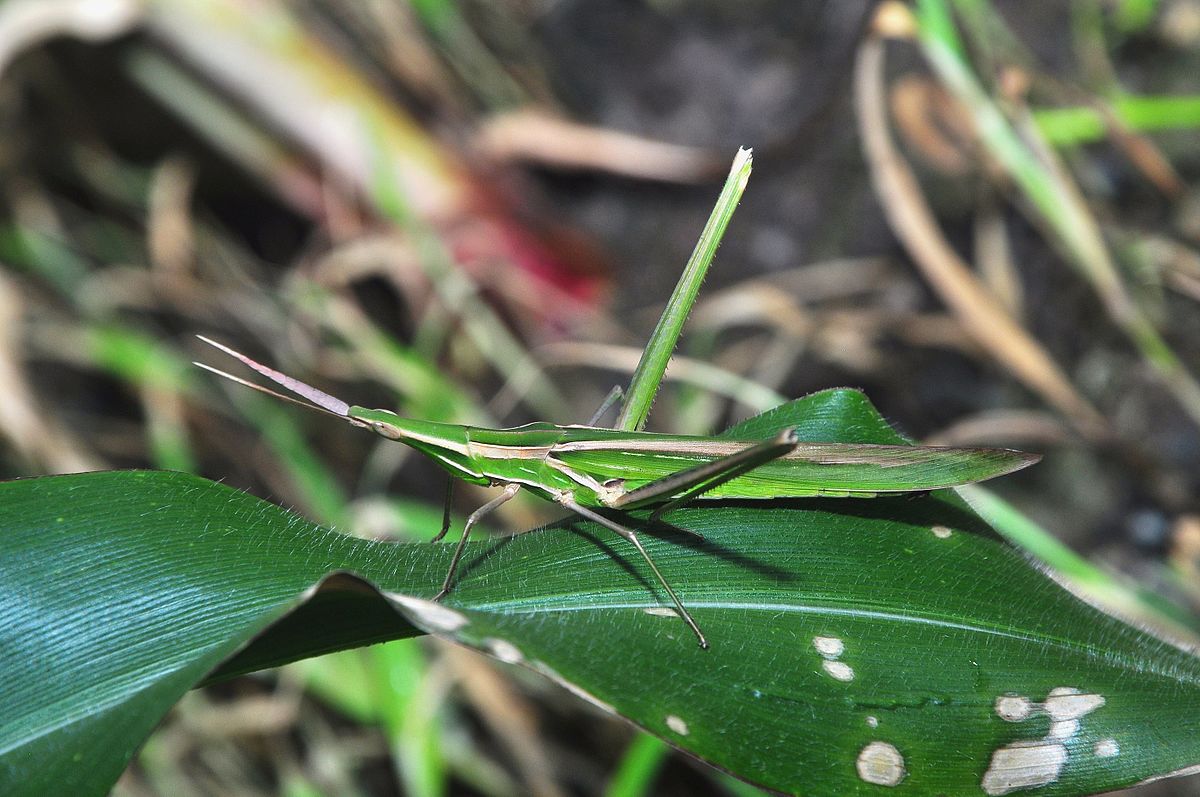
Grasshopper Identification
Identifying silent slant-faced grasshoppers is straightforward due to their unique appearance. Their forewings have angled tips instead of the usual rounded or pointed tips found in other species. Additionally, their heads are not positioned vertically, unlike many other grasshopper species.
Band-Winged Grasshoppers (Oedipodinae)
Band-winged grasshoppers form a diverse subfamily of long-horned grasshoppers known as Oedipodinae. This group encompasses hundreds of species distinguished by their characteristic hindwings. Many band-winged grasshoppers exhibit vivid hindwings adorned with red or yellow patterns accented by black edges. Some species feature black hindwings with lighter-colored margins. On average, band-winged grasshoppers measure approximately 1.88 inches (48 mm) in length.
Here are identification features of some band-winged grasshoppers:
Bryodemella tuberculate
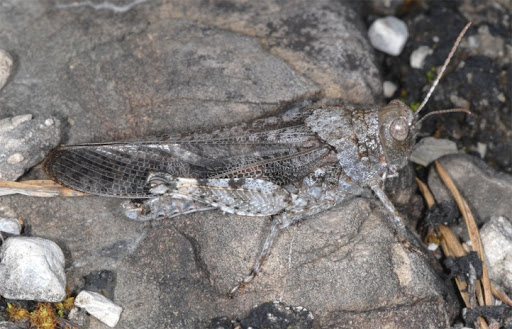
Bryodemella tuberculate is a relatively large grasshopper characterized by its greenish coloration. It features distinct creamy mottled patterns on its wings and legs.
Arphia xanthoptera
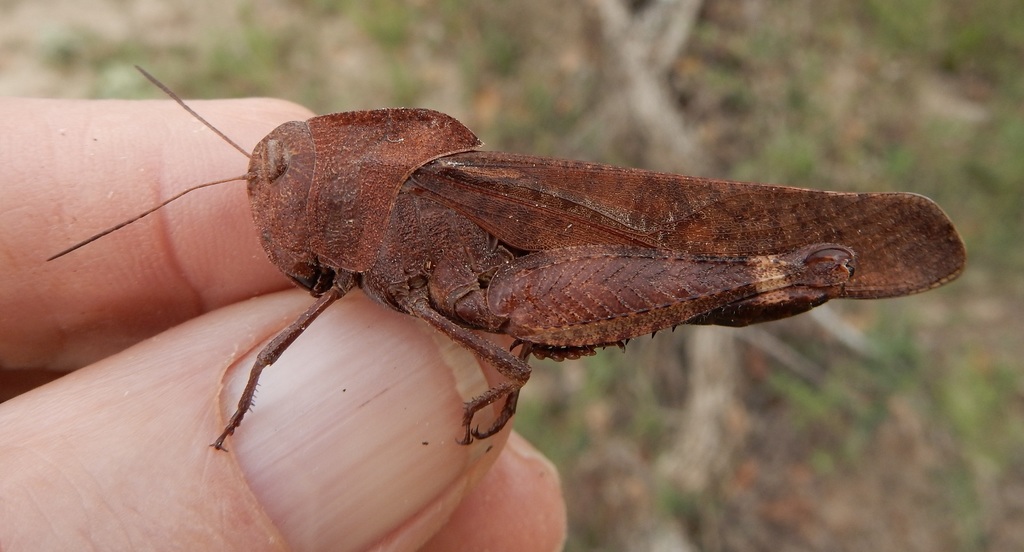
Arphia xanthoptera, or the southern yellow-winged grasshopper, is found in the southeastern United States. It measures 0.8 to 1.2 inches in length and stands out with yellow wings marked with black. These grasshoppers prefer open grasslands and meadows, where they feed on grasses and plants. Males produce buzzing sounds by rubbing their hind legs against their wings during courtship.
Chortophaga viridifasciata
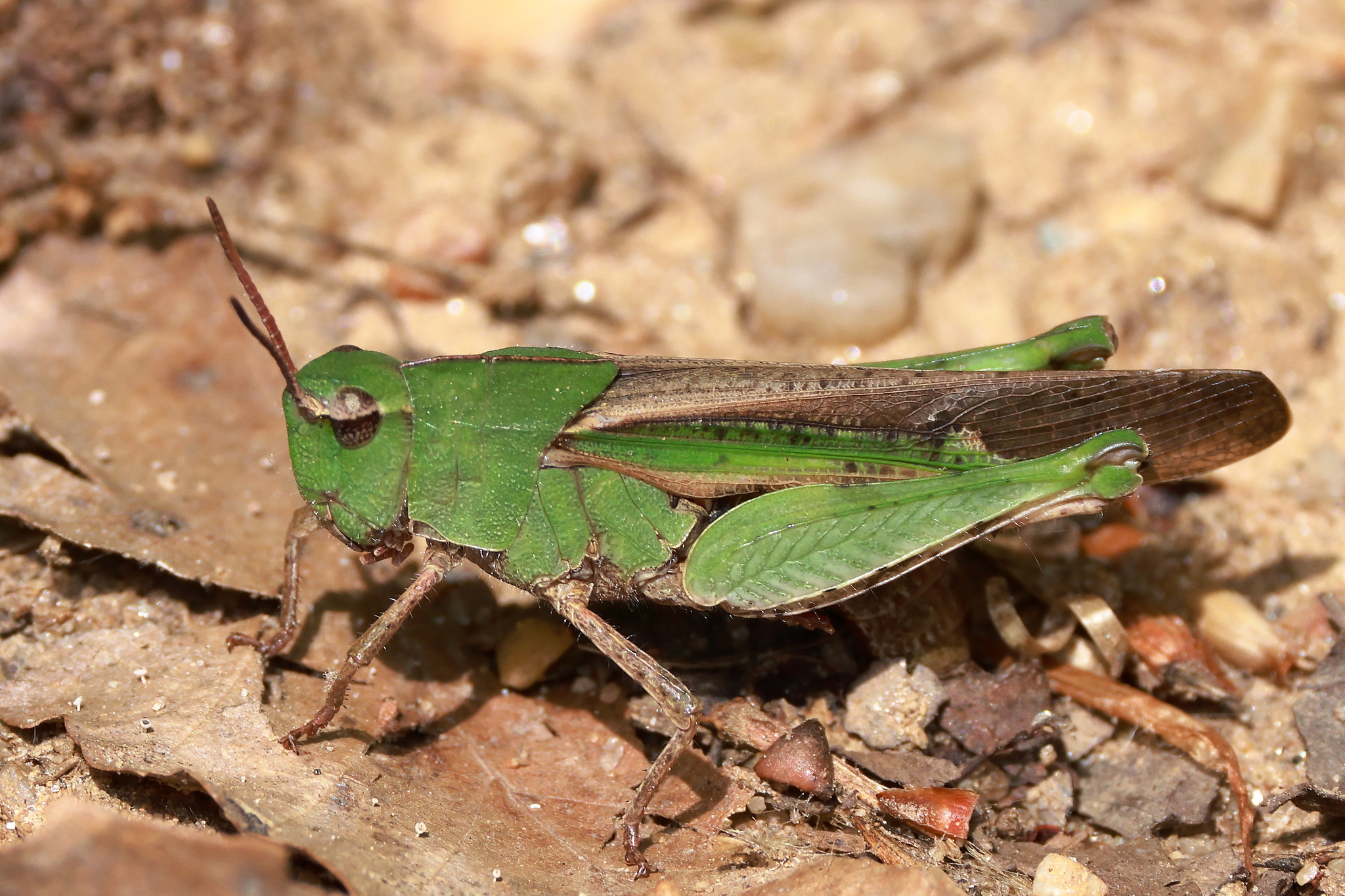
Chortophaga viridifasciata, known as the green-striped grasshopper, is found in North America. It measures 0.8 to 1.2 inches long and has a green body with distinctive yellow or whitish stripes along its sides and back. These grasshoppers inhabit grasslands and fields, feeding on grasses and plants, and are active during the warmer months from spring to fall.
Pygmy Grasshoppers (Tetrigidae)

Pygmy grasshoppers (Tetrigidae) are small, typically less than 1 centimeter long. They have compact bodies, short antennae, and are found in grasslands and meadows worldwide. These agile insects feed on grasses and small plants, playing roles in ecosystem health as herbivores and prey.
In conclusion, understanding the diversity of grasshoppers, from their various sizes and colors to their distinct behaviors and habitats, enriches our appreciation for these remarkable insects. Whether you’re a curious observer or a vigilant gardener, identifying grasshoppers with confidence enhances your understanding of their ecological roles and aids in effective pest management. By utilizing detailed descriptions and illustrative pictures, this guide equips you with the knowledge to distinguish between different types of grasshoppers and appreciate their fascinating diversity in nature.
